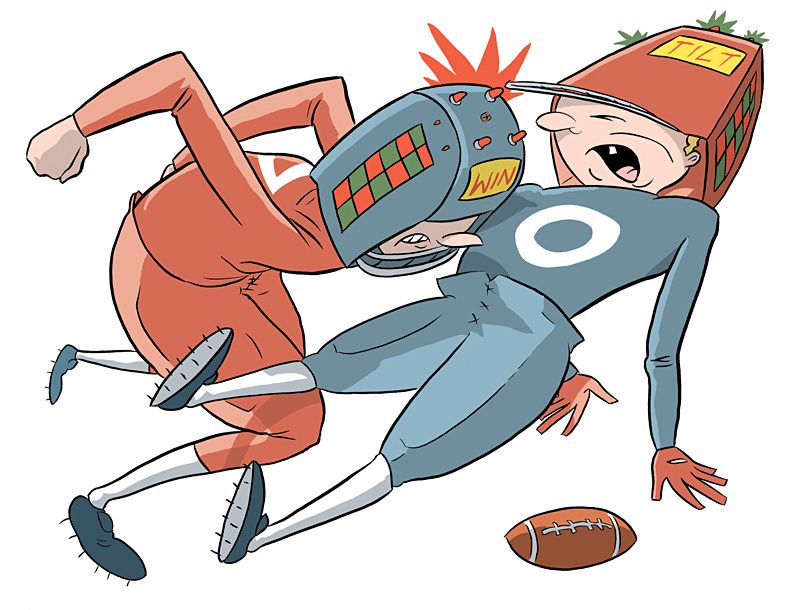AS THE MOST EXPENSIVE baseball stadium in history rises up beside the Kingdome, Seattle Mariners ownership is going ever deeper into the hole. The owners are required to pay cost overruns on the project, which the most recent official estimates peg at $81 million. Meanwhile, with baseball salaries going through the roof, team owners face a hopeless choice: If they put up the immense sums necessary to sign popular superstars Ken Griffey Jr. and Alex Rodriguez, who are entering the final year of their current contracts, they’re financially screwed. If they don’t sign them, fans will abandon the team . . . and they’re financially screwed.
Thus the stage appears to be set for yet another Seattle baseball crisis, the only question being when. Some county officials say privately that they expect it sooner rather than later.
Last month, the public money for building Safeco Field ran out. With six months of construction left, the $372 million in bond proceeds has been exhausted. All construction costs incurred from now until the stadium’s mid-July opening are the responsibility of the Mariners’ owners (a group that includes top Nintendo executives and about a dozen other local techies). So far, the Mariners have paid $22.5 million towards the project (one-half the $45 million they originally pledged). They are supposed to put up the balance of that $45 million by next month. Paying for the remaining overruns will follow.
The price of the ballpark has already climbed by 50 percent since the state Legislature agreed to help fund the project with taxpayer dollars back in late 1995. And construction experts say there could be more inflation ahead—particularly because the stadium is being built on a hurry-up schedule that was mandated by the Mariners.
“It’s very common to see budget changes when you’re in very late stages,” says Bob Sutor, an accountant with expertise in construction costs. “Sometimes, when you’re at 90 percent-plus—that’s when things come home to roost. You have to check all the functionality. If they got to the end and found out the [retractable] roof didn’t operate well, they might have some problems.” (It is worth noting that no one has ever built such a roof before.) While most of the remaining work involves finishing out the ballpark interior—plumbing, concession stands, luxury suites, etc.—the third and largest panel of the moving roof also remains to be built and installed.
The Mariners’ obligation to pay cost overruns is written into the team’s lease. Two years ago, before King County agreed to sell public bonds for the project, independent legal experts hired by the county raised questions about how well “defined” that obligation really was. The experts were also concerned about the risks presented by the team’s financing arrangements, since the owners intended to use a credit line backed only by future stadium revenues, without any personal guarantees. Those concerns and many others were washed away by the now-famous news conference in which tearful team owner John Ellis announced he was putting the team up for sale—a move that immediately ended serious negotiations with King County, and set the County Council into immediate bond-selling action.
Ken Johnsen, head of the Public Facilities District—the quasi-governmental organization that is overseeing ballpark construction—says he has no doubt that the Mariners will meet their obligation. “They have done everything they said they would up to now. They’ve been a good partner.” Johnsen says the PFD has reviewed the Mariners’ finances and is “confident they have the arrangements in place to cover the [overruns].” The PFD’s attorney, Gerry Johnson of Preston, Gates, says, “There’s never been a question about the Mariners not paying their bills. The Mariners have an unconditional, unqualified obligation to pay any cost overruns.”
IF THE OVERRUNS runneth over and the Mariners find themselves drowning in red ink, where could they turn? Apart from simply asking for a cash-filled suitcase from Ron Sims, there are few places left for the owners to reach for more public funds. The team’s lease already entitles it to 100 percent of the income from the stadium and calls for it to pay the Public Facilities District just $700,000 per year in rent (with annual adjustments for inflation). The city of Seattle has already given up its 5 percent admissions tax and pledged the money to pay for the stadium parking lot—from which the Mariners will collect all revenues.
Remarkably, the Mariners do appear to be leaving a few public dollars on the table. In the dark days after Ellis’ news conference two years ago, the team demanded that the city of Seattle pick up the tab for game-day costs, such as traffic-control cops and neighborhood litter cleanup. Then-Mayor Norm Rice was pretty much ready to give in, but the City Council objected. Now, the Mariners are again agreeing to pay those costs, which will likely come to somewhere around $1 million a year, according to Nancy Ousley of the city’s Office of Strategic Planning.
An informal survey done by Mariners management indicated that other baseball clubs who’ve recently moved into new stadiums got a revenue boost of $15 million to $30 million per year. But in lobbying for their new playground, team ownership sidestepped the issue of escalating player salaries. Now, salaries are rising so rapidly—ex-Mariner pitcher Randy Johnson, for example, will be earning $13.1 million per year for the next four years pitching for the Arizona Diamondbacks—that Griffey and Rodriquez alone could each demand more than the Mariners take in from the new ballpark’s much-ballyhooed new revenue streams. (One recent prognostication has Griffey signing baseball’s first billion-dollar contract in 2000.) As a result, the Mariners may well end up farther behind the economic curve in their new ballpark than they were last year in the Dome.







